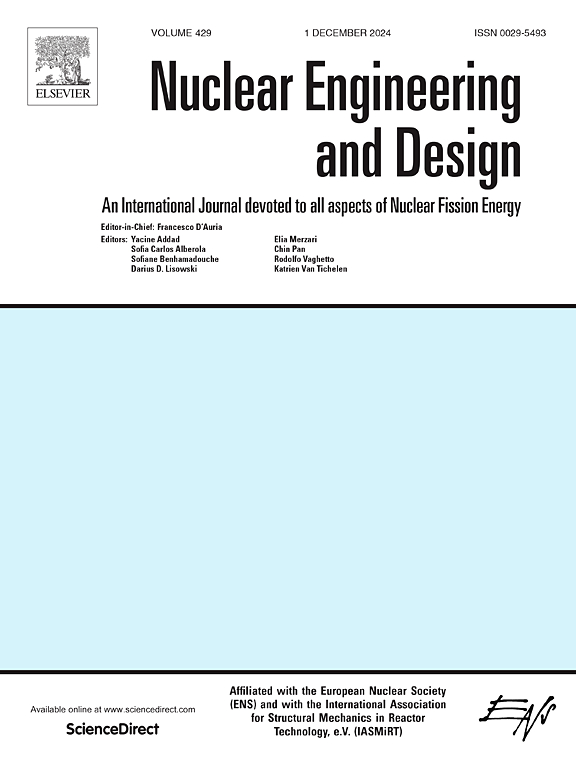轻水堆堆芯工况下沸腾两相水流内部结构的实验研究
IF 2.1
3区 工程技术
Q1 NUCLEAR SCIENCE & TECHNOLOGY
引用次数: 0
摘要
在斯德哥尔摩皇家理工学院(KTH)设计和制造了一个实验装置,用于研究原型轻水堆(LWR)堆芯条件下沸腾两相水流的内部结构,包括与压水堆、沸水堆和小型堆设计相关的条件。该装置基于高压水测试(HWAT)回路,设计压力为25 MPa,水质量流量为1 kg/s,热功率为1 MW。该设施已经更新了新的测试部分和先进的仪器系统,可以在稳态和瞬态操作下进行强制对流和自然循环的测量。这种新颖的实验装置允许首次测量高压低水堆堆芯条件下局部两相流参数的径向分布。所得数据旨在增强对沸腾两相流现象的基本理解,有助于发展封闭定律(包括多分散流),并支持计算代码(1-D和3-D)的验证。本文介绍了环路的设计,带有相关不确定度的更新仪器,以及数据后处理方法(包括离散相位长度尺度的推导)。介绍了热平衡试验和单相试验等调试试验的结果。给出了高压沸腾两相流测量的实例并进行了讨论。识别并量化了孔隙率径向分布、混合速度、界面长度尺度和多分散特征等基本行为和相关关键参数。本文章由计算机程序翻译,如有差异,请以英文原文为准。

Experimental investigation of the internal structure of boiling two-phase water flow under LWR core operating conditions
An experimental setup has been designed and manufactured at the Royal Institute of Technology (KTH) in Stockholm to investigate the internal structure of boiling two-phase water flow under prototypical Light Water Reactor (LWR) core conditions, including those relevant to PWR, BWR and SMR designs. The setup is based on the High-pressure WAter Test (HWAT) loop, designed for 25 MPa pressure, 1 kg/s water mass flow rate and 1 MW thermal power. The facility has been updated with a new test section and advanced instrumentation systems to enable measurements in both forced convection and natural circulation, under steady-state and transient operations. This novel experimental setup allows for the first-time measurements of radial distributions of local two-phase flow parameters under high-pressure LWR core conditions. The resulting data is intended to enhance the fundamental understanding of boiling two-phase flow phenomena, contribute to the development of closure laws (including for polydispersed flow) and support the validation of computational codes (1-D and 3-D). The paper presents the loop design, the updated instrumentation with associated uncertainties, and data post-processing methods (including the derivation of dispersed phase length scales). Results from commissioning tests, such as heat balance tests and single-phase tests, are presented. Examples of high-pressure boiling two-phase flow measurements are presented and discussed. Fundamental behavior and associated key parameters, including radial distributions of void fraction, mixture velocity, interfacial length scales and polydispersed characteristics, are identified and quantified.
求助全文
通过发布文献求助,成功后即可免费获取论文全文。
去求助
来源期刊

Nuclear Engineering and Design
工程技术-核科学技术
CiteScore
3.40
自引率
11.80%
发文量
377
审稿时长
5 months
期刊介绍:
Nuclear Engineering and Design covers the wide range of disciplines involved in the engineering, design, safety and construction of nuclear fission reactors. The Editors welcome papers both on applied and innovative aspects and developments in nuclear science and technology.
Fundamentals of Reactor Design include:
• Thermal-Hydraulics and Core Physics
• Safety Analysis, Risk Assessment (PSA)
• Structural and Mechanical Engineering
• Materials Science
• Fuel Behavior and Design
• Structural Plant Design
• Engineering of Reactor Components
• Experiments
Aspects beyond fundamentals of Reactor Design covered:
• Accident Mitigation Measures
• Reactor Control Systems
• Licensing Issues
• Safeguard Engineering
• Economy of Plants
• Reprocessing / Waste Disposal
• Applications of Nuclear Energy
• Maintenance
• Decommissioning
Papers on new reactor ideas and developments (Generation IV reactors) such as inherently safe modular HTRs, High Performance LWRs/HWRs and LMFBs/GFR will be considered; Actinide Burners, Accelerator Driven Systems, Energy Amplifiers and other special designs of power and research reactors and their applications are also encouraged.
 求助内容:
求助内容: 应助结果提醒方式:
应助结果提醒方式:


